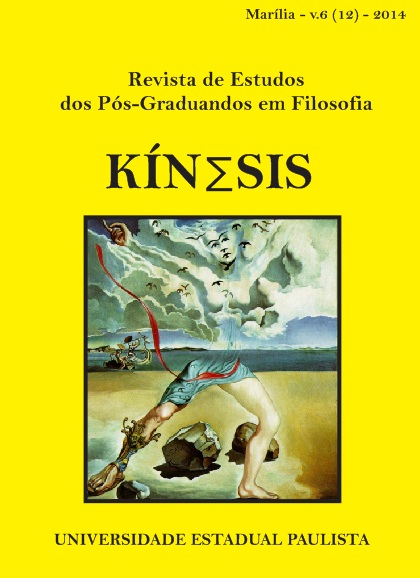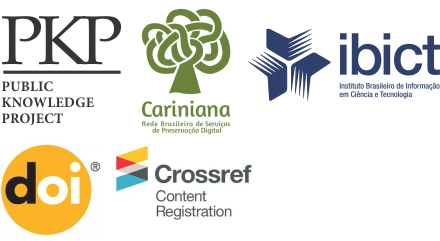NEUROFILOSOFIA DA RACIONALIDADE: CRÍTICAS E PROPOSTAS A PARTIR DA FILOSOFIA E DAS NEUROCIÊNCIAS
DOI:
https://doi.org/10.36311/1984-8900.2014.v6n12.4801Palavras-chave:
Racionalidade, Filosofia, Neurociência, Razão e Motivos, NeurobiologiaResumo
A neurociência visa entender o funcionamento do cérebro e sua influência no comportamento consciente. Achados neurocientíficos recentes sugerem que processos decisórios são causados por eventos neurobiológicos. A partir destes achados, alguns neurocientistas “decidiram” defender a hipótese de que o cérebro seria o real causador das ações. O determinismo neural implícito sugere que “racionalidade” e “consciência” seriam ilusórias. Esta visão vai contra uma concepção clássica de racionalidade. Contudo, aceitar ou não esta nova ideia requer um tipo de racionalidade mínima capaz de estabelecer a verdade ou a falsidade das proposições, e que permite emitir juízos acerca das coisas. Além disso, o alegado novo conhecimento neurocientífico não parece robusto o suficiente para apoiar um argumento em favor da substituição da concepção clássica de racionalidade. Este texto visa discutir a plausibilidade desta argumentação através da análise de três casos paradigmáticos da literatura
neurocientífica e da proposição de um modelo de racionalidade restrita exclusiva do Homo Sapiens.
Downloads
Referências
ARISTÓTELES. A Política. Texto disponível em
http://www.elivrosgratis.com/download/357/politica-aristoteles.html.
BEHRENS, T. E. J., L. T. HUNT, ET AL. The Computation of Social Behavior.Science
(5931): 1160-1164, 2009.
BOÉCIO. Contra Eutychen et Nestorium. Die Theologischen Traktate. Hamburg, 1988.
BARKER, F. G. Phineas Among the Phrenologists: The American Crowbar Case and
Nineteenth-Century Theories of Cerebral Localization. Journal of Neurosurgery 82(4):
-682, 1995.
BANKS, W. P. & POCKETT, S. Benjamin Libet’s Work on The Neuroscience of Free Will. In M. Velmans & S. Schneider (eds.) The Blackwell Companion to Consciousness. Blackwell, 2007.
BLOOR, D. Knowledge and Social Imagery. Routledge, London, 1976.
BECHARA, A., DAMASIO, H. ET AL. Deciding Advantageously Before Knowing the Advantageous Strategy. Science 275(5304): 1293-1295, 1997.
BEHRENS, T. E. J., HUNT, L. T. ET AL. The Computation of Social Behavior.Science324(5931): 1160-1164, 2009.
BEEVERS, C. G. ET AL. Associations between Serotonin Transporter Gene Promoter Region (5-HTTLPR) Polymorphism and Gaze Bias for Emotional Information. Journal of Abnormal Psychology, vol. 120, no. 1, pp. 187-197, 2011.
BURNS, K. & A. BECHARA. Decision Making and Free Will: A Neuroscience Perspective. Behavioral Sciences & The Law 25(2): 263-280, 2007.
CHANGEUX, J-P. & GAREY, L. Neuronal Man, the Biology of Mind. Princeton University Press, 1991.
CHERNIAK, C. Minimal Rationality. MIT Press, 1986.
DAMASIO, H., ET AL. The Return of Phineas Gage: Clues about the Brain from the Skull of a Famous Patient .Science 264(5162): 1102-1105, 1994.
DAW, N. D. Dopamine: at the Intersection of Reward and Action. Nature Neuroscience10(12): 1505-1507, 2007.
DAVIDSON, D. Problems of Rationality .Oxford University Press, USA. 2004.
DE SOUSA, C. E. B. O Processo de Formação de Proposições e a Possibilidade da Dúvida no Sobre a Certeza de Wittgenstein. Argumentos Revista de Filosofia, Ano 5, nº 9, 2013.
______. Classical vs. Bounded Rationality: An Overview. Artigo apresentado à Universidade de Konstanz como um dos requisitos para o recebimento do título de doutor. Artigo submetido, 2009/2014.
______. Redução nas Ciências Especiais: O Caso da Neurociência. In: Anais do VII Simpósio Internacional Principia. 2011.
DOYA, K. Modulators of Decision Making. Nature Neuroscience 11(4), 410-416, 2008.
EAGLEMAN, D. Incógnito – As Vidas Secretas do Cérebro. Editora Rocco, Rio de Janeiro. 2012.
EGAN, M. F., ET AL. Effect of Comt Val 108/158 Met Genotype On Frontal Lobe Function And Risk For Schizophrenia. Proceedings of the National Academy Of Sciences 98(12): 6917-6922, 2001.
FELLOWS, L. K. The Cognitive Neuroscience of Human Decision Making: A Review and Conceptual Framework. Behavioral and Cognitive Neuroscience Reviews 3(3): 159-172, 2004.
FEYERABEND, P. Against Method. Verso, London, 1975.
FRANK, M. J.,ET AL. Prefrontal and Striatal Dopaminergic Genes Predict Individual Differences In Exploration and Exploitation. Nature Neuroscience 12(8): 1062-1068, 2009.
FRIED, I., ET AL. Internally Generated Preactivation of Single Neurons In Human Medial Frontal Cortex Predicts Volition. Neuron 69(3): 548-562, 2011.
GIGERENZER, G. Adaptive Thinking: Rationality in the Real World. New York: Oxford University Press, 2000.
GIGERENZER, G. Bounded and Rational. In Stainton, R. J. (ed.) Contemporary Debates in Cognitive Science. Blackwell Publishing, 2006.
GILOVICH, T., GRIFFIN, D. & KAHNEMAN, D. Heuristics and Biases: The Psychology of Intuitive Judgment. Cambridge University Press, 2002.
HAGGARD, P. Conscious Intention and Motor Cognition. Trends in Cognitive Sciences9(6): 290-295, 2005.
HAGGARD, P. Human Volition: Towards a Neuroscience of Will. Nature Review Neuroscience 9(12): 934-946, 2008.
HAGGARD, P. Decision Time for Free Will. Neuron 69(3): 404-406, 2011.
HANNUN, Y. A. & BOUSTANY, R. M. Apoptosis in Neurobiology. Taylor & Francis, 2002.
HAYNES, J.-D., &REES, E G. Decoding Mental States from Brain Activity In Humans. Nature Review Neuroscience 7(7): 523-534, 2006.
HAYNES, J.-D., ET AL.Reading Hidden Intentions in The Human Brain.Current Biology 17(4): 323-328, 2007.
HEMPEL, C. G. Rational Action. Proceedings of the American Philosophical Association Vol. 35, pp. 5-23, 1962.
JESSUP, R. K., &O’DOHERTY, E. J. P. Human Dorsal Striatal Activity during Choice Discriminates Reinforcement Learning Behavior From the Gambler’s Fallacy. The Journal of Neuroscience 31(17): 6296-6304, 2011.
KAHNT, T., GRUESCHOW, M., SPECK, O. E HAYNES, J. D. Perceptual Learning and Decision-Making in Human Medial Frontal Cortex. Neuron 70, 549-59, 2011.
KAHNT, T., HEINZLE, J., PARK, S. Q. E HAYNES, J. D. The Neural Code ofReward Anticipation in Human Orbitofrontal Cortex. Proceedings of the National Academy of Sciences of the USA 107, 6010-5, 2010.
KANT, I. Anthropologie in pragmatischer Hinsicht. Texto disponível em http://archive.org/details/immanuelkantsan00kantgoog.1833.
KUHN, T. The Structure of Scientific Revolutions. University Of Chicago Press, 1970.
KUEPPER, Y., WIELPUETZ, C. ET AL. 5-HTTLPR S-Allele: A Genetic Plasticity Factor Regarding the Effects of Life Events on Personality? Genes, Brain and Behavior, 2012.
LATOUR, B. & WOOLGAR, S. Laboratory Life: The Construction of Scientific Facts.Princeton University Press, 1986.
LIBET, B. Unconscious Cerebral Initiative and the Role of Conscious Will in Voluntary Action. Behavioral and Brain Sciences 8(4): 529-539, 1985.
LIBET, B., A. FREEMAN, ET AL. The Volitional Brain: Towards a Neuroscience of Free Will. Thorverton, Imprint Academic, 1999.
MACMILLAN, M. Phineas Gage – Unravelling the Myth. The Psychologist, Vol. 21, Part 9, 2008.
MACMILLAN, M. An Odd Kind of Fame: Stories of Phineas Gage. The MIT Press; 1st Edition, 2000.
NOZICK, R. The Nature of Rationality. Princeton University Press, 1994.
O’DOHERTY, J., ET AL. Dissociable Roles of Ventral and Dorsal Striatum inInstrumental Conditioning. Science 304(5669): 452-454, 2004.
PERRY, E. K., H. ASHTON, ET AL. Neurochemistry of Consciousness: Neurotransmitters in Mind. Amsterdam; Philadelphia, J. Benjamins Pub. Co., 2002.
PESSIGLIONE, M., ET AL. Dopamine-dependent Prediction Errors Underpin RewardSeeking Behaviourin Humans.Nature 442(7106): 1042-1045, 2006.
PLATT, M. L. Neural Correlates of Decisions. Current Opinion in Neurobiology 12(2): 141-148, 2002.
POHL, R. Cognitive Illusions: A Handbook on Fallacies and Biases in Thinking, Judgment and Memory. Hove; New York, Psychology Press, 2004.
PURVES, D. Principles of Cognitive Neuroscience. Sunderland, Mass., Sinauer Associates, 2008.
RAKIC, P. Neurogenesis in Adult Primate Neocortex: An Evaluation of the Evidence. Nature Review Neuroscience 3(1): 65-71, 2002.
RESCHER, N. Rationality: A Philosophical Inquiry into the Nature and the Rationale of Reason. Oxford, Clarendon Press, 1988.
RIBA, J., ET AL. Dopamine Agonist Increases Risk Taking But Blunts Reward-Related Brain Activity. PLOS One 3(6): E2479, 2008.
ROGERS, R. D. The Roles of Dopamine and Serotonin in Decision Making: Evidence from Pharmacological Experiments in Humans. Neuropsychopharmacology 36(1): 114-132, 2011.
SÊNECA, o Jovem. Moral letters to Lucilius (Epistulaemorales ad Lucilium) Texto disponível em http://en.wikisource.org/wiki/Moral_letters_to_Lucilius. . 1917.
SHIMA K., & TANJI J. Neuronal Activity in the Supplementary and Presupplementary Motor Areas for Temporal Organization of Multiple Movements.Journal of Neurophysiology 84:2148 –2160, 2000.
SINGER, W. Der Beobachter im Gehirn. Essays zur Hirnforschung .Suhrkamp, Frankfurt Am Main, 2002.
SINGER, W. Ein neues Menschenbild? Gespräche über Hirnforschung. Suhrkamp, Frankfurt Am Main, 2003.
SINGER, W. Verschaltungen legen Uns fest. Wir sollten aufhören, von Freiheit zu sprechen. In: Geyer, Christian (Hrsg.):Hirnforschung und Willensfreiheit. Zur Deutung der neuesten Experimente. Suhrkamp, Frankfurt, 2004.
SPOHN, W. The Many Facets of the Theory of Rationality. Croatian Journal ofPhilosophy 2 (3):249-264, 2002.
SOON, C. S., ET AL. Unconscious Determinants of Free Decisions in the Human Brain. Nature Neuroscience 11(5): 543-545, 2008.
VON WRIGHT, G. H. Explanation and Understanding. Cornell University Press, 1971/2004.
WITTGENSTEIN, L. Über Geweißtheit. Werkausgabe in 8 Bänden, Frankfurt am Main: Suhrkamp, 1984.
WOOD, R. M., ET AL. Effects of Tryptophan Depletion on the Performance of an Iterated Prisoner’s Dilemma Game in Healthy Adults. Neuropsychopharmacology 31(5): 1075-1084, 2006
Downloads
Publicado
Edição
Seção
Licença
Copyright (c) 2014 Kínesis - Revista de Estudos dos Pós-Graduandos em Filosofia

Este trabalho está licenciado sob uma licença Creative Commons Attribution-NonCommercial-ShareAlike 4.0 International License.





